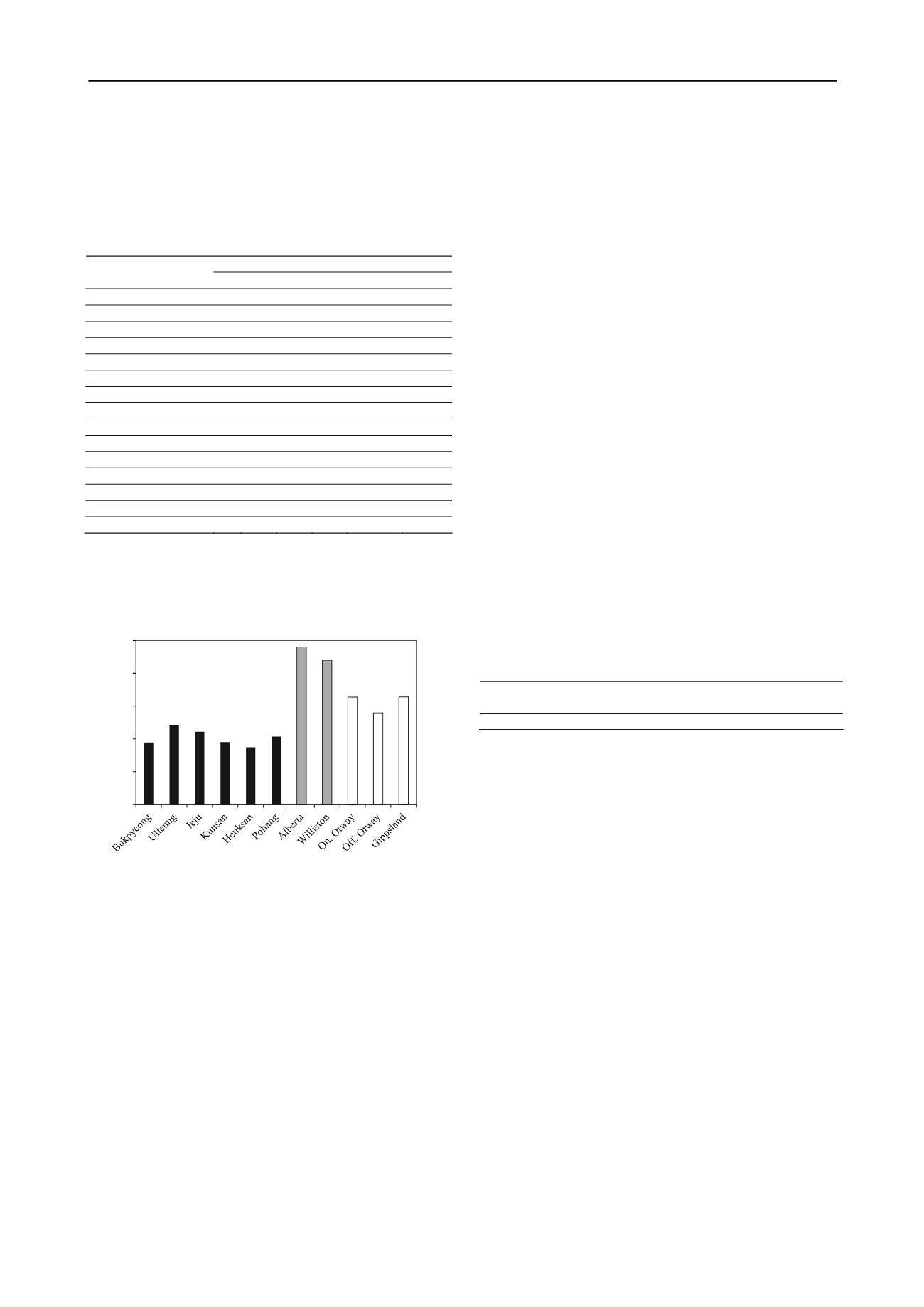
569
Technical Committee 102 /
Comité technique 102
for assessing the suitability of the proposed sedimentary basins
for geological sequestration and for comparing it with basins in
other countries in which pilot- and commercial-scale projects
are already underway.
Table 2. Scores and weight assigned to the criteria and classes for
assessing sedimentary basin in terms of their suitability for CO
2
sequestration in geological media (Bachu, 2003)
Scores
Weight
Criterion
j
=1
j
=2
j
=3
j
=4
j
=5
Tectonic setting
1 3 7 15
15 0.07
Size
1 3 5 9
0.06
Depth
1 3 5
0.07
Geology
1 3 7
0.08
Hydrogeology
1 3 7
0.08
Geothermal
1 3 7
0.10
Hydrocarbon potential
1 3 7 13
21 0.06
Maturity
1 2 4
10 0.08
Coals and CBM
1 2 5
0.04
Salts
1 2 3
0.01
On/offshore
1 4 10
0.10
Climate
1 2 4 7
11 0.08
Accessibility
1 3 6 10
0.03
Infrastructure
1 3 7 10
0.05
CO
2
Sources
1 3 7 15
0.09
The evaluation results are summarized in Figure 2. Among
other sites, the Ulleung basin was evaluated to be the most
suitable site for geologic CO
2
storage in Korea due to the
presence of nearby infrastructure as constructed for natural gas
recovery.
Figure 2. Scores for suitability for of Korean sedimentary basins.
However, the proposed sites in Korea are less feasible for
geologic CO
2
storage compared to the basins in Canada and
Australia. Specifically, the Korean basins show low scores on
the following criteria: size, hydrocarbon potential, maturity, and
infrastructure. Most Korean sedimentary basins, except the
Ulleung basin, are estimated to be of a small-to-medium size,
whereas the Otway and Gippsland basins in Australia are
categorized as large and the Alberta and Williston basins in
Canada are known to be large to giant in size. Moreover, a lack
of boring studies and geophysical exploration exacerbate the
problems of low maturity and insufficient infrastructure. Thus,
more data acquisition and exploration are required to enhance
the reliability of numerical modeling and simulations for the
first Korean pilot project. Additionally, a new alternative
approach involving the use of deep saline formations should be
considered for safe and economic CO
2
sequestration in Korea
with consideration of the geological characteristics of Korean
basins and their limitations as regards CO
2
injection.
3 GEOPHYSICAL RESPONSES OF CO
2
-CONTAINING
SEDIMENTS
While CO
2
leakage from CO
2
stored sites could cause
serious environmental problems, geophysical survey techniques
are viable methods to detect CO
2
leakage and to identify CO
2
movement. Therefore, understanding the geophysical responses
of Korean sediments during CO
2
injection and storage is
important to ensure safety.
The most widely used geophysical methods are seismic
surveys using P-waves and electrical resistivity surveys
(Nakatsuka et al., 2010). In particular, feasibility of P-wave
surveys for the detection of CO
2
has been examined in
laboratory tests (Shi et al., 2007; Siggins et al., 2010; Xue and
Lei, 2006). Also, it is well known that CO
2
-containing
formations have less stiffness than brine-saturated formations
do (Daley et al., 2008; Lazaratos and Marion, 1997; Mito and
Xue, 2011). Because the physical properties of unconsolidated
sediments are significantly affected by the effective stress as
well as the formation characteristics, achieving an in-situ
effective stress condition is critical to obtain reliable physical
properties of CO
2
-containing sediments, though this may not be
the case for cemented porous media. This section presents the
geophysical responses of sediments in which an in-situ effective
stress condition of the potential CO
2
storage sites was achieved.
3.1
Experimental study
The sediment sampled from the Bukpyeong basin (located
on the east coast of Korea; see Table 1) was used in this study.
The silty sand sample was compacted into a rigid-walled vessel
and was saturated with water. Vertical in-situ effective stress of
15 MPa was then applied. The final porosity resulting from the
applied stress condition was estimated to be 49%.
0
0.2
0.4
0.6
0.8
1
Score
Table 3. Properties of test specimen
property
Soil type
(USCS)
Specific
gravity
Permeability
(cm/s)
D50
(mm)
specimen
Silty sand
2.73
4.2*10
-5
0.15
The test was performed on saturated silty sand under a
supercritical temperature condition (35
°
C) under the effective
stress (15 MPa). The pore water pressure was maintained at 8
MPa using a back pressure regulator. The specimen was then
flooded with supercritical CO
2
. After a pre-determined amount
of CO
2
was injected into a water-saturated sample, the
geophysical responses (P-wave velocity V
P
and electrical
resistivity) were measured and the amount of injected CO
2
was
estimated by measuring the amount of water expelled from the
vessel.
3.2
Results and analysis
The total amount of water expelled by weight was 29.86 g;
thus, approximately 30% of the pore water was displaced with
supercritical CO
2
, indicating that the CO
2
saturation rate was
~30%. The density and solubility of CO
2
at the target
temperature and pressure are 591.85 kg/m
3
(NIST) and 1.35
mol/kg of water (Duan and Sun 2003), respectively.
Accordingly, the total calculated amount of injected CO
2
was
17.29 g.
Figure 3 shows the decrease in V
P
during the CO
2
injection
process. The decrement range is relatively low compared to pre-
existing studies (Shi et al. 2007; Siggins et al. 2010). This can
be explained by the fact that the CO
2
injectivity in sandy soil
specimens is lower than that in sandstone. The electrical
resistivity increased rapidly as CO
2
was introduced. The
convergence of the electrical resistivity indicates a fully
saturated condition in which no more CO
2
can be injected (see
Figure 4). The overall results show that CO
2
can be detected by
measuring the geophysical properties; however, the injected


